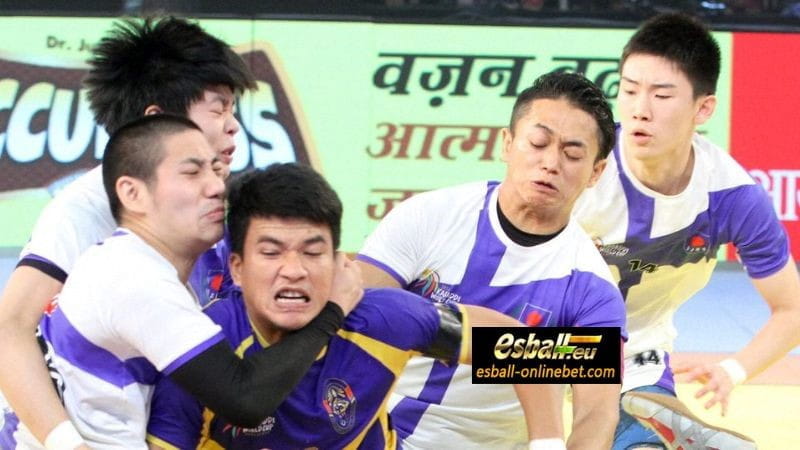Content
Discover the dimensions and features of a Kabaddi ground with this comprehensive guide. Learn about the layout, court markings, measurements, and difference between mat and mud kabaddi courts.
What is Kabaddi?
Kabaddi is an ancient sport that originated in India, requiring a combination of power and skill to play.
This game has been known by different names in different regions of the country, such as CHEDUGUDU or HU-TU-TU in the South, HADUDU for men and CHU KIT-KIT for women in the East, and KABADDI in the North.
One of its unique features is that it can be played with minimal equipment and doesn't require a large playing area. Kabaddi tournaments are held regularly across India.
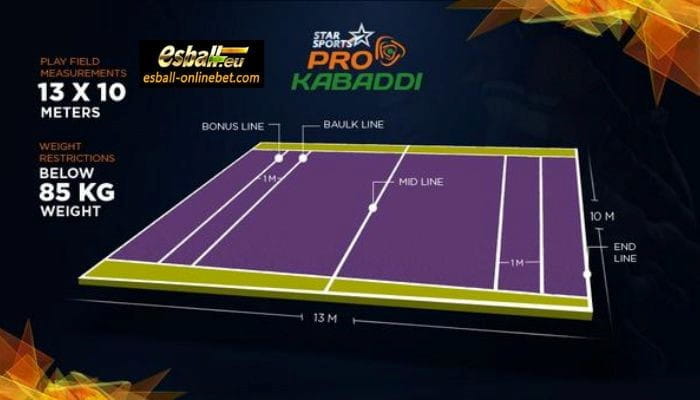
Kabaddi Ground or Playfield
To play Kabaddi, there are specific rules that need to be followed. The setting block should be placed 2 meters away from the end lines and should have a rectangular shape measuring 1 meter by 8 meters for men.
The Kabaddi ground or playing field itself should measure 13 meters by 8 meters (ABCD) for men.
The boundaries or end lines of the kabaddi mat are crucial as they keep the play within its limits. To divide the rectangular court into two equal halves, a midline is drawn parallel to the shorter end lines of the mat.
Kabaddi Baulk Lines:
Each half further contains two additional lines that run parallel to the midline. One of these lines is called the baulk line and is located at a distance of 3.75m from the midline.
Kabaddi Bonus Line:
Another line called the bonus line is drawn 1m further back between the baulk line and the end line.
Kabaddi Lobbies:
Additionally, there are also two channels on the mat known as lobbies, which are created by drawing two lines 1m inside longer boundaries running through its entire length; sometimes marked with different colors on mats for
better visibility.
Kabaddi Ground Markings:
The boundaries of the playing field are marked with lines AB, BC, CD, and DA which should all be between three to five centimeters wide forming an integral part of the playing area. It is important to leave a four-meter clear space outside these boundaries.
Additionally, strips on either side of the playing area called lobbies measure one meter wide each; when included according to rule four under 'Rules of Play,' these extend up to four lines enclosing both sides' playing areas plus their respective lobbies.
Kabaddi Ground Measurement for Men:
| Kabaddi court measurement for men | Meter | Feet |
| Length | 13 | 42.65 |
| Width | 10 | 32.8 |
| Distance from Midline to Baulk line | 3.75 | 12.3 |
| Distance from Baulk line to Bonus line | 1 | 3.28 |
| Lobby width | 1 |
3.28 |
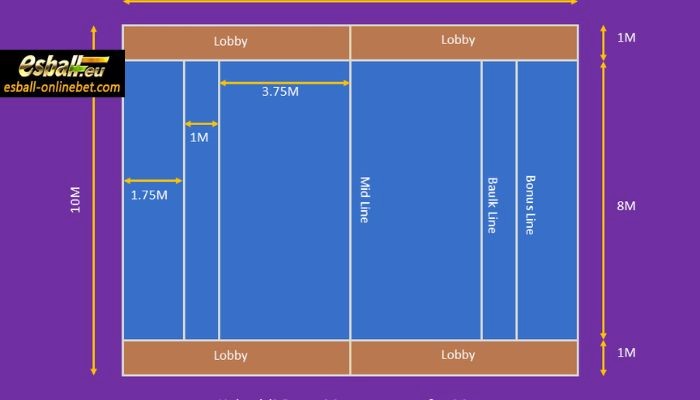
Kabaddi Ground Transformation from Mud to Mat
Kabaddi, a sport with deep roots in India, has made its mark on foreign soil. Despite this, the most significant moments in its history have taken place outside of the country.
In 1996, during monsoon season, E Prasad Rao - former coach for India's gold-medal winning team at the first-ever Asian Games in 1990 - was tasked with coaching Sri Lanka's national kabaddi team.
However, torrential rains prevented the players from training and utilizing their newly acquired coach.
As desperation set in for the Sri Lankan federation, they asked Rao if he could train their players indoors on a taekwondo mat. Though he had never seen one before, Rao agreed to the idea.
While experimenting with kabaddi on wrestling and gymnastic mats had failed due to their softness hindering player mobility, after a month-long training session on the taekwondo mat with his Sri Lankan players, it proved to be just right for kabaddi. This led Rao to develop the idea of playing kabaddi on synthetic surfaces instead of mud.
Rao explained that foreigners are hesitant to walk barefoot or without footwear even in toilets; therefore convincing them to play a sport like a kabaddi without any footwear was always going to be difficult.
The month-long training session gave him confidence that synthetic mats could be used as an alternative surface for playing kabaddi.
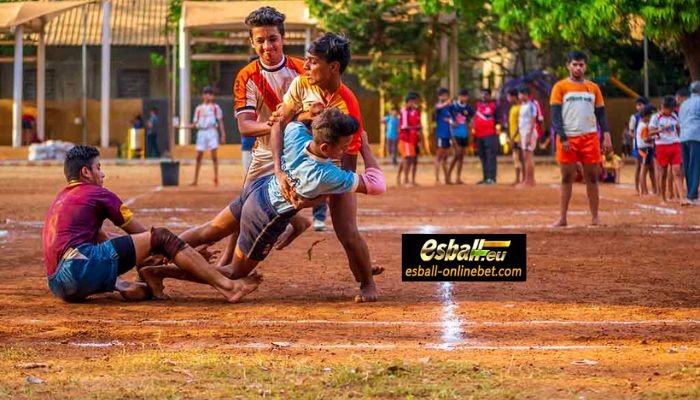
The Making of the Kabaddi Mat
Back in 2002, during the run-up to the Busan Asian Games, kabaddi faced a serious threat of exclusion from the event due to a lack of space to host it. However, Rao had been working on creating an appropriate mat for kabaddi since his time spent in Sri Lanka that same year and felt it was time to take his experimentation to an official level.
Playing barefoot on the mat left players with skinned feet. It quickly became apparent that shoes were needed for playing on this new surface. Initially, wrestling shoes were used but didn't sit too well with players.
Almost seventeen years later, this mat has become kabaddi's preferred playing surface globally; all international and national events are held using it while state and district-level competitions in India are following suit as well.
The move received criticism within some circles of kabaddi as many feared it would go down hockey's path of decline. Nonetheless, players who experienced this transition felt that the mat helped strengthen kabaddi in India as much as it helped gain acceptance worldwide.
Change in Techniques for Playing on Different Kabaddi Fields
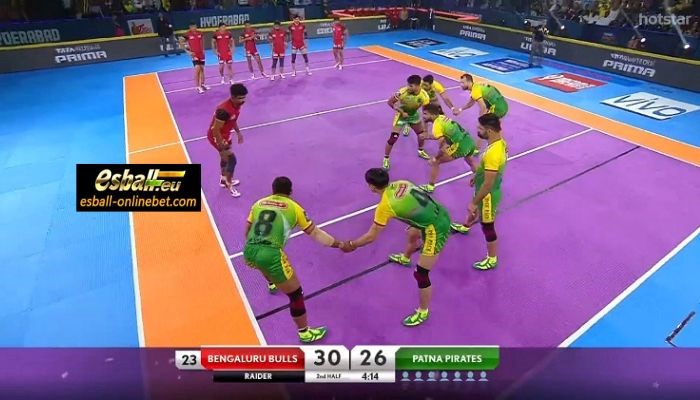
The contrasting properties of the two surfaces necessitated the players to adjust their gameplay to adapt to the new surface. According to BC Ramesh,
"The game on mud and that on the mat is very different. On mud, raiders had to focus heavily on footwork as it was more skill-oriented. However, simply relying on skill doesn't suffice anymore. On the mat, speed has become a crucial factor and it's all about combining your skill, speed, and strength."
The mud surface offers less friction, allowing for more skidding of the foot, whereas, on the mat, there is greater friction, resulting in a firmer grip for the foot.
Perks & Detriments of Mat and Mud Surfaces
This comes with its own set of advantages and disadvantages as explained by Rakesh Kumar who happens to be India's most accomplished kabaddi player:
"ForOn the other hand, defenders have an easier time absorbing shock when they clash with raiders due to loo raiders, executing a variety of skills such as jumps or bupkis becomes easier on the mat due to better footing. However, these skills are harder to pull off on mud as raiders often slip while attempting them."
Dealing with Mat Injuries
Kabaddi has undergone numerous technical changes over the years, including the transition of Kabaddi Ground from mud to the mat.
While this change has resulted in fewer bruises for players, it has also made them more susceptible to serious joint and muscle injuries due to the increased friction and faster pace of the game on the new surface.
As former kabaddi player Rakesh Kumar noted, maintaining a high level of fitness is crucial for avoiding injuries on the mat.
? Claim 2025 IPL Free Casino Bonus Now ?
Click the picture to unlock the promotion and receive your exclusive IPL Esball Casino Code Bonus No Deposit!
Don't miss out on your chance to claim up to 50,000 for FREE! Only valid from 4/21! ⏳



